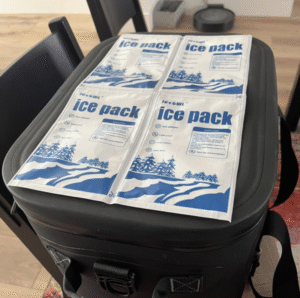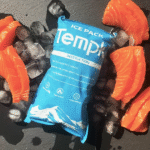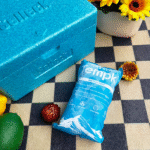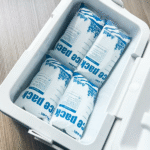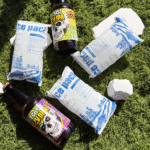Wie funktioniert der Trockeneispack?? Eine vollständige Anleitung zur Trockeneiskühlung
Trockeneisbeutel sind unverzichtbar für Branchen, die beim Versand auf eine präzise Temperaturkontrolle angewiesen sind. In diesem Artikel wird erklärt, wie Trockeneisbeutel funktionieren, ihre Vorteile, und wie man sie effektiv in der Kühlkettenlogistik einsetzt. Egal, ob Sie Lebensmittel versenden, Arzneimittel, oder Laborproben, Wenn Sie die Mechanismen von Trockeneis verstehen, können Sie Ihre Versandstrategie erheblich verbessern.
-
Welche Vorteile bietet die Verwendung von Trockeneis für den Versand??
-
Wie schneidet Trockeneis im Vergleich zu normalem Eis zur Kühlung ab??
-
Welche Sicherheitsvorkehrungen sind bei der Verwendung von Trockeneis zu beachten??
Wie halten Trockeneisbeutel niedrige Temperaturen aufrecht??
Trockeneis ist die feste Form von Kohlendioxid (Co₂). Bei -78,5°C (-109.3° F), Trockeneis untermauert direkt von fest zu Gas, Es nimmt Wärme aus der Umgebung auf und kühlt die Umgebung. Dieser Prozess, Sublimation genannt, stellt sicher, dass Trockeneisbeutel über längere Zeiträume extrem niedrige Temperaturen aufrechterhalten können, im Gegensatz zu normalem Eis, das zu Wasser schmilzt.
Warum ist Trockeneis besser als normales Eis??
Trockeneis bietet im Vergleich zu normalem Eis eine bessere Kühlleistung. Es hält Temperaturen weit unter dem Gefrierpunkt von Wasser und hinterlässt keine Feuchtigkeit, Damit eignet es sich ideal für den Transport temperaturempfindlicher Güter wie Lebensmittel, Impfungen, und biologische Proben.
Beispiel für reale Welt:
In der Pharmalogistik, Trockeneis ist für den Transport von Impfstoffen, die zwischen -50 °C und -70 °C gelagert werden müssen, von entscheidender Bedeutung. Ohne Trockeneis, Diese Produkte könnten zerfallen, bevor sie ihren Bestimmungsort erreichen.
| Besonderheit | Trockeneis | Normales Eis | Vorteile |
|---|---|---|---|
| Temperatur | -78.5°C (-109.3° F) | 0°C (32° F) | Trockeneis sorgt für Minustemperaturen |
| Kühldauer | Bis zu 48 Std. | 4-6 Std. | Längere Kühldauer |
| Rückstand | Sublimates zu Gas, keine Feuchtigkeit | Schmilzt in Wasser | Kein Durcheinander, Ideal für Trockenware |
Wie schneidet Trockeneis im Vergleich zu normalem Eis zur Kühlung ab??
Im Vergleich zu normalem Eis, Trockeneis bietet erhebliche Vorteile bei der Langzeitkühlung, insbesondere für Sendungen, die Temperaturen unter dem Gefrierpunkt aufrechterhalten müssen. Trockeneis hält länger und vermeidet die Unordnung, die mit schmelzendem Wasser einhergeht, Damit ist es die erste Wahl in der temperaturempfindlichen Logistik.
Trockeneis vs. Normales Eis:
-
Trockeneis sublimiert zu Kohlendioxidgas und hinterlässt keine Rückstände, während normales Eis schmilzt und Wasser entsteht, Dadurch könnte die Ware möglicherweise beschädigt werden.
-
Trockeneis ist ideal für dauerhafte Sendungen 24-48 Std., wohingegen normales Eis häufig ersetzt werden muss.
Sicherheitsaspekte bei der Verwendung von Trockeneis
Beim Umgang mit Trockeneis ist aufgrund der extremen Kälte und der Möglichkeit der Kohlendioxidbildung Vorsicht geboten. Befolgen Sie diese Sicherheitsrichtlinien, um eine ordnungsgemäße Handhabung zu gewährleisten:
-
Tragen Sie isolierte Handschuhe: Trockeneis kann bei direktem Hautkontakt schwere Erfrierungen verursachen.
-
Stellen Sie eine ordnungsgemäße Belüftung sicher: Trockeneis setzt beim Sublimieren Kohlendioxidgas frei, was Sauerstoff in engen Räumen verdrängen kann. Verwenden Sie Trockeneis immer in gut belüfteten Bereichen.
-
Lagern Sie niemals Trockeneis in luftdichten Behältern: Der Druck des Sublimationsgases könnte zum Platzen der Behälter führen.
So packen Sie Trockeneis für den Versand ein
Um die Kühlvorteile von Trockeneis zu maximieren, Stellen Sie sicher, dass Ihre Verpackung gut isoliert und ausreichend belüftet ist:
-
Wählen Sie den richtigen Behälter aus: Verwenden Sie isolierte Behälter, die den Sublimationsprozess verlangsamen.
-
Trockeneis richtig schichten: Legen Sie Trockeneis auf den Boden des Behälters und stellen Sie sicher, dass eine Barriere zwischen Trockeneis und den Produkten besteht.
-
Beschriftung richtig: Kennzeichnen Sie Behälter mit entsprechenden Gefahrenaufklebern, um auf das Vorhandensein von Trockeneis hinzuweisen (UN1845).
2025 Trends bei der Verwendung von Trockeneis
In 2025, Der Trockeneisverbrauch nimmt aufgrund der Zunahme des E-Commerce zu, Pharmazeutische Sendungen, und Nachfrage nach temperaturempfindlichen Gütern. Fortschritte in der Verpackung, nachhaltige Produktionsmethoden, und Automatisierung in der Schifffahrt verbessern die Effizienz und Umweltfreundlichkeit des Trockeneistransports.
Schlüsselinnovationen:
-
Verbesserte Verpackungslösungen: Neue Materialien, die die Kühldauer verlängern und gleichzeitig den Abfall reduzieren.
-
Nachhaltige Produktion: Forscher konzentrieren sich auf die umweltfreundliche Herstellung von Trockeneis, wie zum Beispiel die Nutzung von CO₂ aus Industrieabfällen.
-
Automatisierte Versandsysteme: Technologie, die temperaturempfindliche Sendungen präzise verwaltet, Trockeneis nahtlos in die Lieferkette integrieren.
Häufige Verwendungen von Trockeneis
Trockeneis hat vielfältige Einsatzmöglichkeiten, insbesondere in Branchen, die zuverlässige Kühllösungen benötigen:
-
Pharmazeutika & Impfungen: Stellt sicher, dass Impfstoffe und empfindliche Medikamente während des Transports gefroren bleiben.
-
Lebensmittel Lieferung: Hält die Temperatur von Tiefkühlkost während des Ferntransports aufrecht.
-
Laborforschung: Konserviert biologische Proben bei extrem niedrigen Temperaturen.
Beispielfall:
In der Biotechnologiebranche, Trockeneis wird zum Transport von Zellproben verwendet, die während der gesamten Transportdauer gefroren bleiben müssen. Dies stellt ihre Eignung für Forschung und Analyse bei ihrer Ankunft sicher.
Häufig gestellte Fragen
Q1: Wie lange kann Trockeneis niedrige Temperaturen aufrechterhalten??
Trockeneis kann Temperaturen unter dem Gefrierpunkt aufrechterhalten 24-48 Std., Abhängig von der Isolierung und der Menge des verwendeten Trockeneis.
Q2: Ist trockeneis sicher zu handhaben?
Trockeneis ist sicher, wenn es mit Vorsicht gehandhabt wird. Tragen Sie immer Handschuhe, in gut belüfteten Räumen verwenden, und sorgen Sie für eine ordnungsgemäße Lagerung.
Schlussfolgerung und Empfehlungen
Trockeneisbeutel sind ein unverzichtbares Werkzeug für Branchen, die während des Versands eine präzise Temperaturkontrolle benötigen. Sie bieten erhebliche Vorteile gegenüber normalem Eis, inklusive länger anhaltender Kühlung, keine Wasserrückstände, und die Fähigkeit, extrem niedrige Temperaturen aufrechtzuerhalten.
Nächste Schritte:
-
Für Unternehmen: Erwägen Sie die Verwendung von Trockeneis für Ihre temperaturempfindlichen Sendungen, um die sichere und effiziente Lieferung Ihrer Produkte zu gewährleisten.
-
Für Verbraucher: Befolgen Sie beim Umgang mit Trockeneis stets die Sicherheitsrichtlinien und sorgen Sie für eine ausreichende Belüftung, um eine CO₂-Ansammlung zu vermeiden.
Über Tempk
Tempk ist auf die Bereitstellung zuverlässiger Kühlkettenlogistiklösungen spezialisiert, Wir bieten Trockeneisprodukte an, die auf Ihre Versandanforderungen zugeschnitten sind. Unsere Trockeneis-Akkus sorgen für Sicherheit, effizient, und konformer Transport temperaturempfindlicher Güter.
Aufruf zum Handeln:
Benötigen Sie kompetente Beratung bei der Auswahl der richtigen Kühlkettenlösung für Ihre Produkte?? Wenden Sie sich noch heute an Tempk!






